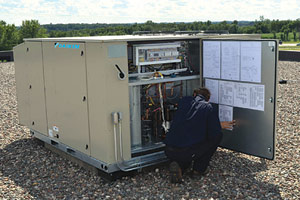
|
| In response to DOE’s Rooftop Unit Challenge initiative, Daikin designed the Rebel rooftop heat pump, which achieves part-load efficiencies of up to 19.2 IEER. |
The energy-efficiency ratings of residential air-source heat pumps have risen dramatically over the last few years, with many manufacturers now offering equipment well exceeding the 20-SEER mark. There have been significant gains made in commercial heat pump efficiencies as well, thanks to the growing demand from building owners and managers, who are looking for ways to save energy.
The Department of Energy (DOE) is also encouraging owners to replace their equipment with high-efficiency systems, noting that many rooftop units, in particular, are past their typical life spans and function at much lower efficiency levels than new units. With the large stock of aging commercial equipment out there, now is the perfect time for contractors to help owners and managers think proactively about replacing their old units with more efficient heat pumps.
The Challenge
The DOE is serious about encouraging owners to reduce energy consumption in commercial buildings, which is why it issued a challenge to manufacturers several years ago to design higher efficiency 10- to 20-ton air conditioners and heat pumps. The DOE estimated that the new high-efficiency units would reduce energy by as much as 50-60 percent over current equipment.
Daikin Applied rose to the challenge and introduced the Rebel rooftop heat pump, which achieves part-load efficiencies of up to 19.2 IEER and surpasses ASHRAE’s 90.1 minimum standard by up to 80 percent. The Air-Conditioning, Heating, and Refrigeration Institute (AHRI)-certified, VAV, air-to-air system is available in sizes ranging 3-15 tons and offers heat pump technology with gas, electric, or steam heat options, direct drive variable ECMs on all fans, electronic expansion valves, an energy recovery wheel, and a variable-speed Daikin inverter scroll compressor.
“These variable-speed inverter scroll compressors result in exceptional energy savings, better temperature control, and quick payback,” said Skip Ernst, marketing manager, rooftop systems, Daikin Applied. “Aerodynamic outdoor fan blades and enclosed compressors greatly reduce full-load radiated noise to whisper-quiet operation, while airfoil indoor fan blades and low velocities significantly reduce full-load ducted noise. All Rebel fans and compressors operate at reduced speeds at part load for increased efficiencies.”
The one-piece Rebel can be installed in new construction and retrofit applications, and factory-installed-and-tested packages include economizers, exhaust fans, energy recovery wheels, and several heat options that eliminate field coordination and leakage problems that can occur with field installation. MicroTech® III unit controls with Open Choices provide interoperability with BACnet™ or LonMark™ communications for easy integration into building automation systems.
The Rebel took five years to perfect, primarily due to the fact that it took time to build a state-of-the-art heat pump test lab that could test for safe operation at any ambient temperature, airflow, and speed. And while a high-efficiency Rebel unit requires a higher initial investment, said Ernst, the cost to operate and maintain it is significantly less, resulting in much lower life cycle costs and total payback in as little as two years. “Rebel is the ideal solution to assist with the reduction of energy costs across the commercial building sector with up to 80 percent energy savings and strikingly lower building operating costs.”
High-Efficiency Options
Carrier Corp.’s highest efficiency heat pump for light commercial applications is its WeatherMaster® Series, which is available in sizes ranging 3-10 tons. These AHRI-certified units have SEER ratings up to 15.8, COP ratings up to 3.5, and feature reliable defrost control logic, ECMs, and a factory-installed suction line accumulator to protect the compressor at switch-over times and extreme ambient conditions.
“Our WeatherMaster units are total package units,” said Ted Cherubin, commercial marketing manager, Carrier. “They are pre-engineered, certified, and tested, so there is no special training or criteria to install and maintain them. The use of hinged access doors and a tool-less filter door help significantly with routine maintenance, and the units are compatible with existing Carrier roof curbs dating back to the late 1980s, which makes replacement of past electric heat or gas heat models possible.”
There are no geographic limits on where WeatherMaster units may be installed, and Carrier software can help building owners and managers determine payback quickly and easily, said Cherubin. “For heat pumps to be a sound investment for a building owner, they must be able to save energy. Incentives such as utility rebates for heat pump use would further increase the demand for these products, but we still continue to see growth in commercial heat pumps, especially in the South. We see this mostly because, as replacement opportunities arise, heat pumps are displacing electric heat models, which were very prevalent about 15 years ago.”
Trane, a subsidiary of Ingersoll Rand, offers high-efficiency products including the Precedent™ and Voyager™ package heat pumps, available in sizes ranging 3-10 tons and 12.5-20 tons, respectively. “These units come standard with ReliaTel microprocessor controls, which meet ASHRAE minimum-efficiency levels, and provide reliable performance and optimized operational efficiency,” said Shawn Wood, Voyager rooftop product manager, Trane.
“Geographic regions that are not as humid or have mild winters are great candidates for these heat pumps, including the Southwest U.S. and select East Coast areas from the Carolinas to Virginia,” said Wood. “These units are often installed in schools, retail developments, and small office spaces. With building owners and managers becoming concerned over rising energy costs, their interest in energy-efficient equipment will continue to increase.”
With this increased interest in high-efficiency commercial equipment, contractors can expect to see manufacturers offer even more energy-saving equipment going forward.
Publication date: 5/26/2014
Want more HVAC industry news and information? Join The NEWS on Facebook, Twitter, and LinkedIn today!



Report Abusive Comment